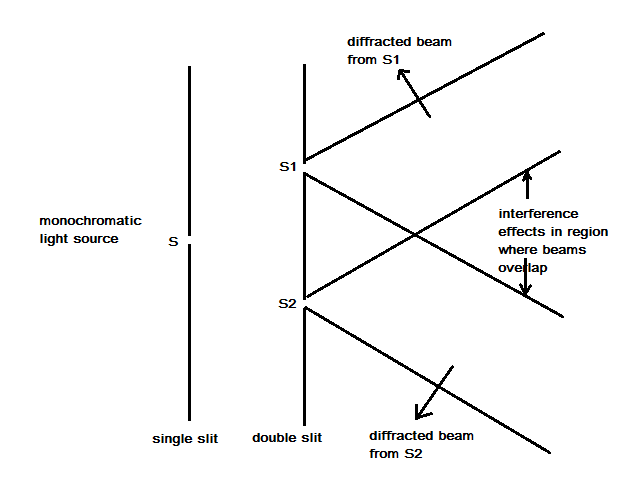
How is fringe width of an interference in Young’s double slit experiment affected if the two slits are brought closer to each other?
Answer
435k+ views
Hint: Here, it is asked that what happens to the fringe width of interference in Young’s double slit experiment when the slits are brought closer. For this we have to study the Young’s double slit experiment thoroughly and understand the properties of interference and its patterns.
Complete answer:
Monochromatic light (single wavelength) from narrow vertical slit S falls on two narrow slits S1 and S2 which are very close together and parallel to S. S1 and S2 act as two coherent sources (both being derived from S). If S, S1 and S2 all are very narrow, diffraction (bending of light at openings whose width is of the order of wavelength of light) causes the emerging beams to spread into the region beyond the slits. Superposition occurs in the shaded area, where the diffracted beams overlap. Alternate bright and dark equally spaced vertical bands (interference fringes) can be observed on a screen placed at some distance from the slits. If either of S1 or S2 is covered, the fringes disappear. Consider figure given below:

Interference: The phenomenon in which two waves superpose to form the resultant wave of the lower, higher or same amplitude. The most commonly known interference is the optical interference or light interference.
Complete answer:
Monochromatic light (single wavelength) from narrow vertical slit S falls on two narrow slits S1 and S2 which are very close together and parallel to S. S1 and S2 act as two coherent sources (both being derived from S). If S, S1 and S2 all are very narrow, diffraction (bending of light at openings whose width is of the order of wavelength of light) causes the emerging beams to spread into the region beyond the slits. Superposition occurs in the shaded area, where the diffracted beams overlap. Alternate bright and dark equally spaced vertical bands (interference fringes) can be observed on a screen placed at some distance from the slits. If either of S1 or S2 is covered, the fringes disappear. Consider figure given below:

Interference: The phenomenon in which two waves superpose to form the resultant wave of the lower, higher or same amplitude. The most commonly known interference is the optical interference or light interference.
Recently Updated Pages
Class 10 Question and Answer - Your Ultimate Solutions Guide

Master Class 10 Science: Engaging Questions & Answers for Success

Master Class 10 Maths: Engaging Questions & Answers for Success

Master Class 9 General Knowledge: Engaging Questions & Answers for Success

Master Class 10 General Knowledge: Engaging Questions & Answers for Success

Master Class 9 English: Engaging Questions & Answers for Success

Trending doubts
The gas that burns in oxygen with a green flame is class 12 chemistry CBSE

The probability that a leap year will have only 52 class 12 maths CBSE

Describe the poetic devices used in the poem Aunt Jennifers class 12 english CBSE

And such too is the grandeur of the dooms We have imagined class 12 english CBSE

What does the god that failed refer to class 12 english CBSE

Which country did Danny Casey play for class 12 english CBSE




